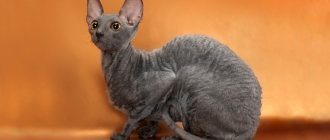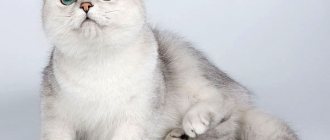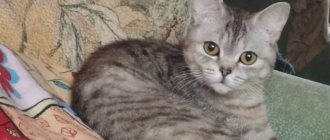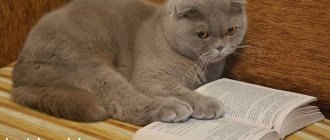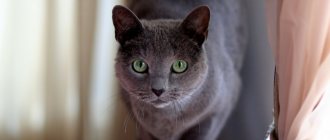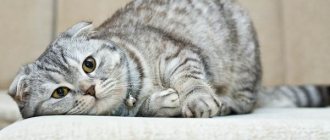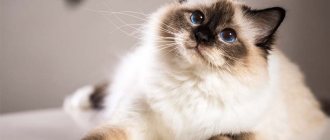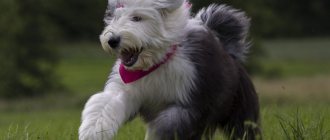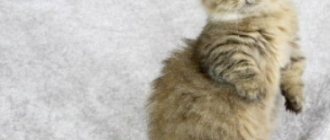The Scottish Straight cat is the “child” of the Scottish Fold. The breed became independent relatively recently. This happened due to the fact that in order for healthy kittens to be born without ear deformation, a cat couple must consist of two different Scots. One of them is straight-eared, the second has flattened ears. But only breeders should delve into these subtleties of breeding. For ordinary people, Scottish straights are large fluffy round clouds that radiate peace and tenderness.
Upon closer contact, it is impossible not to fall in love with one of the plump, purring cats. Thanks to his intelligence, sense of tact and boundless kindness, the Scottish Straight kitten will fit perfectly into any family.
White
The white Scottish Straight is a real miracle, a beautiful, sophisticated animal, the dream of many cat lovers. It’s impossible to look away from the snow-white handsome guy, looking at the world with round, surprised blue eyes. It is believed that owners of a white fur coat are by nature gentle and calm creatures who love to bask in the arms of their beloved owner.
Ginger
A handsome man with a fiery red color almost outshines other colors with the beauty and brightness of his coat. The red kitten looks unusually original and impressive, and the red stripes on the fur, delicate creamy undercoat and golden eyes add even more attractiveness to the cutie. Red kittens have a playful and lively character.
Grey
This color is the most common among straight cats. The gray Scotsman resembles his British relative in the color of his fur coat, but looks more miniature and cute. The solid, rich color of the dense, thick coat makes the baby look like an outlandish animal, and the bright orange eyes enhance this impression.
It is believed that Scots Grays have a calm, phlegmatic character, but they are no less cheerful and active than red ones.
Black
Black straights are unusually elegant and graceful. They can become a true decoration of your home. A shiny, pitch-black fur coat looks incredibly impressive. The aristocratic charcoal color of their coat makes these animals look like a shadow moving unnoticed around the house.
INTERESTING TO FIND OUT: What are the different colors of Abyssinian cats?
The deep, attentive gaze of shining amber eyes is always gentle for the owner, but for strangers it can serve as a warning signal - Scottish Straight black smoke does not like strangers. Scots with this type of color behave with dignity and do not allow unnecessary pranks.
Care and maintenance
Scottish Straights are typical domestic cats for whom walks in the fresh air are pleasant entertainment, but not more than that. This is why Scots are considered ideal pets for homebodies. In everyday life, straights are unpretentious and rarely cause trouble. Take your animal for routine veterinary examinations, carry out timely vaccinations, use high-quality food - and straight-eared Scottish cats will not create any problems for you.
Hygiene
Scottish Straight loves his mistress
Scottish Straights are very clean cats that carefully monitor the condition of their own fur, but they still need to be bathed from time to time. Usually, cats are washed as their “coat” gets dirty, using shampoo from the pharmacy. At the end of the procedure, you can apply a balm to the coat. When bathing, make sure that water does not get into the animal’s ears and be sure to protect the wet pet from drafts.
Owners of show-class specimens preparing to participate in exhibitions will have to work a little harder. In particular, a few months before the event, the cat begins to be washed daily to completely remove dead cells from its skin and stimulate the growth of new fur. In addition, you will have to spend money on a variety of professional coat care products, ranging from degreasing paste to texturizing conditioner. Brush Scottish cats once a week with a short hair brush. Claws are trimmed as they grow. Be sure to monitor the condition of your cat's eyes and remove unwanted discharge with a swab soaked in hygiene lotion.
Feeding
The diet of Scottish Straights is no different from the “menu” of their fold-eared counterparts. Just like folds, Scottish straight-eared cats benefit from lean meat, offal, boiled sea fish, fermented milk products, and egg yolk. In addition, the animal’s diet should include vegetables (raw or stewed), cereals and sprouted wheat.
Prohibited
- Fat meat.
- Beans and potatoes.
- Bones.
- Sweets, spices, smoked foods.
- Garlic and onion.
- Bread.
- River fish.
- Citrus.
- Mushrooms.
- Raw eggs.
Curious Scottish Straight
In serious nurseries, Scottish Straight kittens are sold starting from the age of three months. During this period of life, the baby no longer feeds on mother's milk, which means it is able to eat the same food as an adult animal.
An important point: natural-fed straight cats do not receive enough of the vital microelements. Vitamin and mineral complexes, which can be purchased at a veterinary pharmacy, solve this problem.
Scottish Fold cats can also be fed commercial food if you are willing to spend money on its non-budget varieties - “premium”, “super premium” and “holistic”. An ideal cut for a Scottish dog should contain at least 26% protein and about 9% fat. It is advisable that the food does not contain wheat and corn, which can cause allergies in the cat. From this point of view, the most useful options for “drying” can be considered the Canadian Acana Pacifica Cat and the American Earthborn Holistic.
Three-month-old Scots are fed up to 6 times a day, six-month-old kittens eat 5 times a day, nine-month-old kittens - 4 times. One-year-old individuals are considered adults, so 2-3 meals are enough for them.
Blue
Very often, cats of the Scottish Straight breed have colors of all shades of blue, which give them indescribable grace and sophistication. The color of its fur coat is characterized by a spectacular metallic sheen, giving the animal’s appearance inexpressible grace and charm.
Scottish Straight Blue cats with golden or yellow eyes are inherently calm, but charming kids will never deny themselves the pleasure of being a little naughty.
Lilac
Purple color is quite rare and non-standard. To get such beauty, breeders had to work hard, so such a kitten will not be cheap. The lilac color, unusual for Scottish Straight cats, harmonizes perfectly with the honey eyes of the pet, giving its cute image charm and touching.
Adult lilac cats are extremely elegant and beautiful. Their character is independent and proud, but at the same time loyal and affectionate.
Price
The price of a Scottish Straight cat kitten depends on its parents, rarity of color and class. Class is a kind of gradation of cats, depending on the exterior and the degree of compliance with the breed standard.
Pet class implies the presence of minor deviations that do not affect the health or character of the animal. Sometimes pet-class animals are given for mandatory castration so that the genes are not passed on to future generations. Animals of this class can be purchased for up to $200.
Breed-class cats are subject to breeding; they must have a veterinary passport and birth certificate. The price for a breed-class kitten is from 150 to 300 dollars.
Show class kittens have a stunning exterior and are often purchased for participation in exhibitions. The price of such a pet is at least $350 and above. Do not forget that if you want to purchase a purple animal, you will have to pay even more.
Bi-color
Kittens with multi-colored colors are not so common, and it is impossible to take your eyes off the babies whose fur coats are painted in two shades at once. Color combinations can be any: black and red, black and white, white and gray. According to the official breed standard, bi-colors have yellow eyes, but green ones are also allowed. Seals of this color are not phlegmatic; they spend most of their time in games and fun.
Chinchilla
A kitten or adult Scottish Straight cat with such a spectacular color looks amazing. Breeders do not skimp on laudatory epithets for cats with similar coat colors, comparing them to silver or black pearls. Indeed, wool of such a rare and complex color looks like an exquisite jewel.
Visually, the coat looks like a single color, but if you look closely, you can see a thin “spraying” on the coat. This effect is achieved by painting the ends of the hairs to 1/8 of the length. There are at least ten variations of chinchilla color: lilac, chocolate, as well as cream and red (cameo). The eyes should be green. By nature, chinchillas are calm and friendly.
INTERESTING TO KNOW: Domestic leopard is an Ocicat cat
History of the Scottish Straight cat breed
Scottish Straight cat
Scottish Straight are the same Scottish folds, but with a modified position of the ear. Straight ears do not have a characteristic crease and are set straight, and this, in fact, is the only external sign that distinguishes them from their fold-eared counterparts. Scottish cats are considered one of the youngest cat breeds. The first cat with an unusual, flattened ear shape appeared on a Scottish farm in the early 60s. Surprisingly, the ancestor of modern folds and straights had no pedigree and simply chased mice through the barns of local peasants.
The first official Scottish breeder was an ordinary villager, William Ross, who adopted a kitten from the aforementioned Fold. A few years later, professional breeders also joined the process. At the same time, experts witnessed an interesting phenomenon: in the litters brought by even the most purebred Scottish dogs, babies with erect ears appeared. Of course, no one intended to separate such individuals into a separate breed. And kilometer-long queues did not line up for straight-eared kittens, because against the backdrop of touching folds, they were outright losing. But here nature itself intervened.
Very soon, Scottish breeders noticed that attempts to strengthen and strengthen the lop ears of animals had a negative impact on their health. The mutated gene responsible for the flatness of the ear folds began to inhibit the function of the skeletal apparatus of cats. As a result, the Scots began to suffer from thickening of the bones and osteochondrodysplasia. To keep the breed afloat, breeders rushed to look for “new blood” that would help the Scottish survive and reduce the number of their genetic defects. Through trial, error and outcrossing, it was discovered that the healthiest and most beautiful offspring can be obtained from crossing a Fold cat and a straight-eared male of the same breed. It was thanks to this discovery that breeders and felinological associations finally turned their attention to straight-eared Scots. Well, in 2004, the Scottish Straight subspecies received official recognition from the World Cat Federation and the status of an independent breed, which sharply increased the attractiveness of straight-eared cats in the eyes of potential buyers.
Marbled silver (tabby, tabby)
Scottish straight marble on silver is a worthy specimen that no breeder would refuse. The animal's coat is simply magnificent: a thick white undercoat, on which there are black patterns and stripes. Kittens of such a magnificent color, like those from the Whiskas advertisement, are characterized by huge, expressive yellow eyes. It is believed that marble pussies are very capricious and more touchy than their chocolate relatives.
Tabby Color Genetics
Tabby patterns are caused by three different gene loci and one modifier.
The Agouti gene, with its two alleles A and a, controls whether or not the Tabby pattern is present. The dominant A expresses the basic Tabby pattern, and the recessive "non-Agouti" or "hypermelanistic" allele indicates its absence. Solid (black or blue) cats have an "a" combination that hides the striped pattern, although traces of it can sometimes be seen (called a "ghost stripe"). This basic pattern, whether classic, tabby, spotted or ticked, is most easily distinguishable in bright light during the early stages of a kitten's development and into adulthood on the tail.
However, the Agouti gene only controls the production of black pigment, so a cat with the O allele (responsible for orange or red color) will still express a tabby pattern. As a result, both red cats and red spots on cat skins will always display striped patterns.
The tabby cat's primary pattern gene is dominant, so it is a cat with the Mc genotype (mc or Mc) - mackerel.
The "Mc" set establishes the basic pinstripe pattern (striped mackerel) that underlies the coat. Mc is the wild type Tabby gene. Classic tabby cats are animals that have two copies of the recessive mc, so they are carriers of the mc/mc allele. This is a recessive mutant (not wild type) mc gene that produces the spotted pattern and appears in the cat as the classic pattern of thick stripes with a bullseye pattern on the sides.
The spotted gene is directly related to the Mc gene, it “breaks” the Tabby stripe lines, turning them into spots. It is also dominant, designated Spotted or Sp (sp or Sp). Sp together with Mc and Agouti make up various combinations - mc and Mc/Mc and A/ a and A/A.
The Ticked tabby pattern is at a different gene locus than the Mackerel and Classic tabby patterns, and is epistatic to (influenced by) other patterns. The dominant Ta/ta mutation masks any other Tabby pattern, creating a striped background or agouti stripe with virtually no lines. If the Ticked tabby pattern gene is present, any other Tabby pattern is masked.
Cats homozygous for the marked allele (Ta/ta) have fewer medallion defects than cats heterozygous for the marked allele. When a cat of this genetic makeup is selectively bred for lack of faults and broad stripes on the hair shaft, the resulting pattern is called shaded.
There are additional alleles and even additional genes influencing Tabby patterns that have also been identified and postulated.
The three most common alleles in order of dominance are Ta, the allele for ticked patterns as in the Abyssinian type, Tm, for tabby mackerel, and the recessive tb for classic.
The Ta allele is dominant over Tm and tb.
A cat with the Ta allele will express a ticked tabby pattern (only with stripes on the paws if there is only one copy and none at all if there are two), and a cat with two tb alleles will express the classic stripe pattern.
The wild type is the mackerel (the stripes look like thin fish bones and can break up into linear markers or spots), the most common variety is the classic striped pattern (wide stripes, curls and spirals of dark color on a pale background, usually with bullseye on the side) and, Perhaps the most famous of the less common tabby cat designs is the “swoosh.”
Classic tabbies are most often found in Iran, England and the lands that were once part of the British and Persian empires. The gene responsible for differentiation pattern formation was named transmembrane Q (Taqpep), which also underlies the coat color of the king cheetah.
King Cheetah
Other pattern modifier genes are responsible for creating different types of spotting, many of which are variations of the basic mackerel or classic pattern. There are also hypothetical factors that influence the timing and frequency of Agouti shifts, affecting the width of its band and the quantity and quality of alternating eumelanin and pheomelanin lines on individual hairs.
There is also a gene, not yet identified but believed to be related to the Agouti gene, in the Chausie breed that produces silvery black fur similar to the Abyssinian. It is assumed that the "gray" phenomenon is inherited from the hybridization of the domestic cat with the House (Felis chaus).
Black Chausie
The pigment gene, I/i, is also inhibited. The dominant allele (I) produces hairs with tips of a different color, which are completely colored only on it and have a white base. This allele appears to interact with other genes to cause varying degrees of coloration, ranging from dark-tipped silver tabby to lightly shaded silver and silver chinchilla. The inhibitor gene interacts with the non-Agouti genotype (I-aa) to produce a color known as smoke.
The homozygous recessive genotype combined with the agouti gene (iiA) produces the Tabby's coloration, which can range across the spectrum from a deep-patterned brown tabby to a light yellowish, slightly tinted golden or chinchilla gold. Orange cats with the inhibitor (IO) gene are commonly called "cameos".
Still, the Tabby pattern exists thanks to the Agouti gene. Their stripes have an even distribution of pigment, while the background consists of banded hairs. Tabby cats usually have the following characteristics:
- Mark in the form of the letter "M" on the forehead. Visible in marked tabby cats, but difficult to distinguish in darkened silver and golden animals.
- Thin “pencil” lines on the muzzle. Clearly visible in tabby cats, but more difficult to notice in darkened silver/golden pets.
- Black "eyeliner" and white or pale fur around it.
- Pigmented lips and paw pads.
- Pink nose with darker pigment.
- Ring “girth” of the body, legs and tail. The stripes on the torso disappear when the color is ticked.
Marble on gold
Exquisite and rich color, quite rare among straight cats. Golden wool has clear dark stripes in the form of various black shapes, zigzags, and stripes. Animals with silver and gold marbled colors have the letter “M” on their foreheads, and their eyes are predominantly yellow and copper.
A kitten that has such a luxurious color has a freedom-loving character and does not tolerate coercion. As a rule, owners try to give their pets sophisticated nicknames.
Calico (patchwork turtle)
Only Scottish Straight cats can have this color. The main white color of the fur coat is effectively combined with two more colors: red, black, cream. They say that a three-colored “child”, which must have a corresponding nickname, brings happiness.
It’s hard to say whether this is true or not, but it’s a fact that no one can remain indifferent to such a lovely little girl. Tortoiseshell cats are in high demand among breeders, because later they can produce kittens of a wide variety of colors.
Breed characteristics
The Scottish Straight cat is an affectionate, sociable and devoted animal. She is not very active and as she grows up, her interest in outdoor games remains behind. Possesses good health. Scottish Straights are very friendly and sociable animals. Average life expectancy is 12-15 years.
Coat and color
The Scottish Straight cat is the owner of a chic short fur coat. It feels like soft plush to the touch and you just want to touch it! The fur covers the body tightly.
Depending on the type of color of the animal, the texture of the coat also changes.
Scottish Straights are awarded by nature with a large number of colors, and each of them is recognized as a standard. The most common cats are:
- plain;
- tortoiseshells (tricolor);
- marble;
- tabby (hunting pattern of stripes, curved lines and dots);
- striped;
- bicolor;
- ticking.
Colors can also be different: black, white, brown, gray, harlequin, chinchilla, fawn, blue point, color point, mackerel and others.
Constitution
The appearance of the animal is misleading, as it is too similar to the British Shorthair cat. These breeds do not have much in common, except that both cats come from British lands.
Scottish Straights are distinguished by a rounded skull and a noticeably rounded area of the cheekbones and cheeks. The nose is almost without stop. The eyes stand out on the muzzle - large and perfectly round. Their gaze is open, attentive and as if asking the world about something. The ears are straight, with rounded, straight-looking tips. On the outside they are decorated with short hair, and on the inside with hair brushes that complement the exterior of the muzzle.
Males have more rounded cheeks and cheekbones than females.
What the eyes of an adult cat will look like is determined by the color. Thus, the blue color is characterized by yellow eyes, the golden or silver color is characterized by green eyes, and bicolors, solids, harlequins and vans have blue eyes.
The body of the Scottish Straight cat is long and clearly smaller than the body of the British cat, with whom they are often confused. The body can be called muscular, especially in the pelvis and paws. They are folded proportionally. The paws are powerful, rounded at the ends. The tail is long (it can reach the cat's forelimbs), mobile, round at the end.
Character
The Scottish Straight cat is considered to have an extremely calm and dispassionate character. Let's not deny this - representatives of the breed are indeed distinguished by restraint, although there are individuals who clearly show emotions. Scottish Straights are considered affectionate cats, and this is true - they will happily be near their owner, but still, if you decide to pick up the cat at the wrong time, the animal will definitely report it.
Representatives of the breed are calm and friendly. They get along well with other animals and do not mind being around dogs, provided that you teach the latter to live peacefully. Scottish Straights also treat small children well.
Scots are playful up to the age of one year, just like babies. After this, their interest in activities decreases and they prefer to spend their days contemplating the world and thinking.
You should not test the animal’s patience and create discomfort for it. The cat is proud and values personal space, so attempts to hold it in your arms or active calls to play may be regarded negatively. Animals tolerate loneliness well and do not require constant attention, but are happy to meet their owner after work and spend time with him.
Some say that these cats are highly trainable, while others deny this. It is known for sure that Scottish Straights are smart and can be trained to follow house rules. It is important to do this as soon as you have a kitten. Teach how to use a scratching post and litter box, and the results will not be long in coming!
Color point
A kitten with this color is very beautiful. The plush coat is painted in one color, and on the protruding areas of the body - the muzzle, ears and tips of the paws - there are dark points with clear boundaries, which give the blue-eyed Straight a resemblance to a Siamese. Reviews from the owners of these charming animals indicate that color points are distinguished by their neatness and cleanliness.
Shaded colors
The undercoat is almost white, the ends of the hairs are whitish. Almost the entire edge is covered with one color or another, only the chin and abdomen are completely light.
Shaded can be:
- Golden. The undercoat is light peach, the fur has a golden glow. The eyes are green, the paw pads and nose are dark chocolate.
- Silver. The undercoat is snow-white, the tips of the hairs are dark gray. The eyes are greenish, edged with black. The last feature is characteristic only of the silver variety; other Scottish shaded colors do not have eyeliner. The nose mirror is brick-colored. Black edging of mouth and nose, pads.
- Red, aka Cameo. This variety of shaded color has a snow-white undercoat, and there is a dark red coating on the coat. Only the muzzle and chin, the abdomen and the underside of the tail remain completely light. The eyes are like amber. The nose, eyeliner and pads are pinkish.
